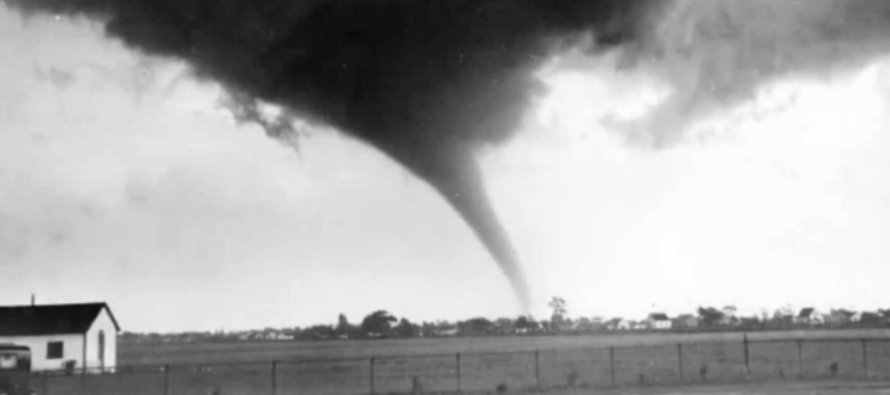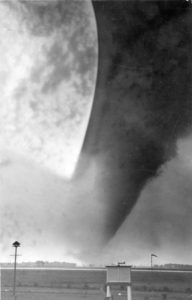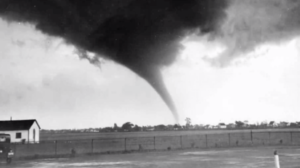The History of Tornadoes in Windsor and Essex County

by Zachary Balogh
Sitting along what is commonly referred to as ‘Canada’s Tornado Alley’ is a major metropolitan city that is no stranger to the rotating column of wind known as a tornado – a city with a rich history of death and destruction from these twisting monsters – Windsor, ON.

An F4 tornado is shown at the Windsor Airport on June 7, 1946. Photo from Wikipedia.
Mark Robinson, a Storm Chaser for The Weather Network, said Windsor is vulnerable to tornadoes.
“Windsor just sort of sits in that one spot where they can actually hit, when they come out of the United States, whereas if you go into places like the GTA, if you’re talking about Toronto, it’s right up against very cold Lake Ontario,” said Robinson.

Mark Robinson Storm Chaser with The Weather Network. Photo by Zachary Balogh
Robinson has had his own experience with tornadoes. He told the story of how his own family had a run in with the more recent twister.
“It missed my father in law’s yacht club, LaSalle Mariners, by like 100 feet, hit the other marina that was just out from there and then went straight across the golf course, and then it got disrupted a little bit, went straight over my sister in law’s house and just kept going,” said Robinson. “But I had no idea while it was happening. I’m following this I’m doing live on-air hits. We’re talking about what’s going on, and I, at this point, have no idea if this has hit my father-in-law. So, by the time I was able to sort of call, I called my mother-in-law and said, ‘Is Dennis, okay?’ And she said, ‘what do you mean?’ I said, ‘there’s a tornado’.” And it turns out he was okay, but he watched it, like, a hundred meters away.”
According to the National Severe Storms Laboratory, tornadoes are a rotating column of wind that extends from a thunderstorm to the ground. Most tornadoes appear invisible unless it contains a condensation funnel made up of water droplets, dust and debris.
Prior to 2007 in the U.S. and 2013 in Canada tornadoes were ranked by a scale known as the Fujita Scale. The Fujita Scale was developed by a meteorology professor at the University of Chicago named Tetsuya “Theadore” Fujita and it was widely used to measure the tornado by the destruction it leaves behind.
In the present-day tornadoes are now ranked by the Enhanced Fujita Scale which was developed in 2007. The EF Scale takes into account more variables than the original F Scale did when assigning a wind speed rating to a tornado according to the National Weather Service. The EF Scale incorporates 28 damage indicators such as building type, structures and trees. For each damage indicator, there are 8 degrees of damage ranging from the beginning of visible damage to complete destruction of the damage indicator. The original F Scale did not take these details into account.
David Sillis executive director of The Northern Tornadoes Project at Western University, explains how tornadoes are rated. Sillis said that it comes down to understanding the structure of the building, which is why he has engineers as part of his team. The engineers can help identify some of the weaknesses and tell if they are well built or not can help give a rating to a specific tornado.
“When we’re applying the rating scale, the Fujita scale, or now it’s the enhanced Fujita scale, it assumes that the construction is of a well-built home or a well-built barn or that kind of thing,” said Sills. “So, a lot of the detective work early on is looking for, you know, was it well-built and can we apply the expected value for that kind of damage to this building or was there some weakness that allowed it to come down sooner or easier?”
The Original Black Death
On a hot and humid June, the Rose City was at the mercy of a black funnel. This was a day that went from great to grim.
According to the Windsor Public Library the Tornado of 1946 was the most powerful tornado, being a category F4 in strength, to ever hit Windsor.
The tornado touched down near River Rouge, Michigan it then crossed the Detroit River and touched down in the Brighton Beach neighbourhood of Windsor. The twister then passed across the south end of the city and northern Sandwich West Township (now called LaSalle). 17 people were killed and hundreds more were injured when the storm was over. Approximately 400 homes were damaged or destroyed, orchards were uprooted, and 15 farm buildings were gone. Many residents were amazed at the intensity of the tornado. Railroad boxcars were thrown off their tracks and tossed onto their sides, roofs of houses were torn off, and some houses were lifted off their foundations. By the time it had ended the tornado is ranked as Canada’s third deadliest tornado behind the Regina Cyclone and The Edmonton Tornado.

Another photo of the F4 tornado at the Windsor Airport on June 7, 1946. Photo from The Weather Network.
Curling Club Nightmare.
Windsor had seen some tornadic activity, although most tornadoes were small and weak. However, things were about to change on the night of April 3, 1974. That day saw a widespread outbreak across North America. In total 174 tornadoes were recorded in what was known as the unprecedented ‘Super Outbreak’.
One of those tornadoes touched down in Windsor. An F3 tornado tore through the southern part of the city after crossing the Detroit River.
The tornado first struck the south part of Devonshire Mall before moving to the Windsor Curling Club on Central Avenue. The tornado ripped the roof off the building, and a concrete wall collapsed. Eight people were killed, with one succumbing to his injuries nine months later. Much of the rescue efforts were carried out in the dark.
The tornado was reported to have a width of more than 300 meters. Although the tornado hit the Curling Club at 8:09 p.m., the tornado warning for the Windsor area, issued by the Canadian Weather Service was issued at 8:15 p.m.
Jim Sarnovsky is a former Windsor resident who now lives in Centerville, Ohio. He said that to this day, that night was unforgettable.
“I remember that day like it was yesterday, I was in my mid-teens. I remember the greenish sky and I was tracking the storm with my older brother. I remember when we heard it hit Xenia, Ohio… and it got eerily still about the time the weatherman said it would hit Windsor,” said Sarnovsky. “I was living in South Windsor at the time. Oddly enough I now live in Centerville, Ohio, about three miles from where the storms became the massive tornado that hit Xenia. I have spoken with first responders about that night. Some things we won’t forget.”
With tornadoes occurring in Windsor more often, it is important to be accurately warned. However, that has not always been the across the country. In 2016 a pair of tornadoes touched down in Windsor and LaSalle, but the warning came from Environment Canada five minutes after the fact.
Sills said The Northern Tornadoes Project also conducted a survey on the warnings issued by Environment Canada and it led to a 30 to 37 per cent grade as a lot of tornadoes were going on undetected.
The Northern Tornadoes Project conducted the same survey during the 2022 tornado season and found improvements were made leading to a grade of 56.
“We repeated the analysis the following year, so for the 2022 season, and Environment Canada had double the amount of tornado warnings and double the amount of tornado watches,” said Sills. “So we know that they heard what we were saying because we said you know you have to be able to be able to get them right and earlier, so you have lead time.”
When tornadoes hit it is recommended that you have a plan in place to protect you and your family.
Emily Bertram, the emergency systems co-ordinator with Windsor Fire and Rescue gave some examples of what to do during a tornado.
“Go to the basement or take shelter in a small interior ground floor room such as a bathroom, closet or hallway and if you have no basement, protect yourself by taking shelter under a heavy table or desk,” said Bertram.
When it comes to certain types of unsafe buildings such as a mobile home Bertram said that more than half of all deaths from tornadoes happen in mobile homes. It is recommended that you find shelter elsewhere, preferably in a building with a strong foundation.
If no shelter is available, lie down in a ditch away from the car or mobile home. Beware of flooding from downpours and be prepared to move.
According to Accu Weather tornadoes have a specific season, in traditional Tornado Alley and the Midwest that time of the year is from April-June, however it has been proven that tornadoes can strike anytime of the year. Experts warn you should never let your guard down no matter what time of the year it is.


